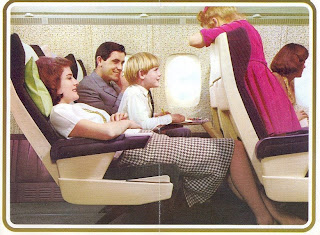I think that the general consensus is that most of us are sick of the airline industry, the long lines, the cramped conditions, the lousy food (unless we are up the front) and all the extra charges. Even with the introduction of new aircraft such as the Airbus A380 and Boeing’s anticipated 787 Dreamliner, I think that we are all a little jaded. I am an airline and plane buff (I know, who would have known) and rather disappointed. The A380 is an ugly plane, that doesn’t conjure up any of the streamlined ideals that we associate with flight.

It was not always like this. The Vickers VC-10 was an incredibly sleek, stylish airliner both inside and out! It was something an airliner should have looked like! The Vickers VC10 is a British airliner designed and built by Vickers-Armstrongs (Aircraft) Ltd and first flown in 1962. The airliner was designed to operate on long distance routes with a high subsonic speed and also be capable of hot and high operations from African airports. The performance of the VC10 was such that BOAC, the initial operator, laid claim to the VC10 providing the fastest crossing of the Atlantic - London to New York, by a jet airliner. This record is still held, to date, by the VC10, for a sub-sonic airliner; only beaten by the supersonic Concorde. What set the VC10 apart was the location of the engines. These were located aft in pods attached to the fuselage below a high T style tail. (Sorry to be technical- but the savoir faire is coming)

With the launch of the VC 10 BOAC held out no stops. Lavish promotional brochures with fabulous artwork highlighted the sleekness and the overall stylishness of this new entry into the jet age. BOAC used word such as aristocrat and superlative with abandon when promoting their new aircraft.
































